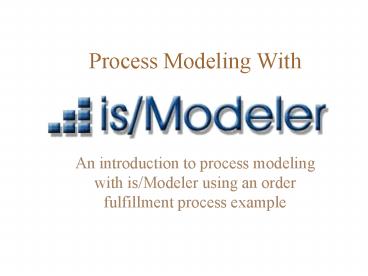Process Modeling With - PowerPoint PPT Presentation
1 / 17
Title:
Process Modeling With
Description:
The carts, trucks, and forklifts in the warehouse are also rented, and cost $12, ... either the standard report formats, or through custom report formats you create. ... – PowerPoint PPT presentation
Number of Views:15
Avg rating:3.0/5.0
Title: Process Modeling With
1
Process Modeling With
- An introduction to process modeling with
is/Modeler using an order fulfillment process
example
2
Introduction
- This presentation provides background information
on a sample business process for order
fulfillment. - Next, you will see how to create a process model
for the order fulfillment process. - Finally, you will see how to use the model in
making business decisions.
3
Overview Intergalactic Widgets Order Fulfillment
Process
- Intergalactic Widgets (IW)sells and distributes
widgets solely by a mail order process. Last year
IW received 260,000 orders from new and existing
customers. Additionally, IW received an average
of 200 orders per week that it was unable to fill
immediately, due to out-of-stock status. Once
stock was replenished, these orders were placed
back into the normal workflow. - The equipment used to sort incoming orders from
other correspondence is leased, and costs IW
20,000 per month. The carts, trucks, and
forklifts in the warehouse are also rented, and
cost 12,000 per workday (3,120,000 annually)
including rental fees and maintenance contracts. - The order system computer compiles all of the
orders that are entered during the course of a
day and prints out a list of items to be shipped
the following morning . It takes a supervisor
about 45 minutes a day to pull the list from the
order system, and about three hours each day to
create a picking schedule.
4
Overview (continued)
- Customers are notified by mail if their order is
back-ordered. It takes about 15 minutes to
correctly set-up each order that has back-ordered
components in the system. Once a week, back-order
notification letters are manually created and
sent to customers, in a process that takes about
12 hours each week. - The staff for order fulfillment breaks down as
follows - Mail Room Clerk 12.00 per hour
- Order Clerk 18.00 per hour
- Warehouse Picker 20.00 per hour
- Warehouse Supervisor 50,000 per year
- Additionally, the IS department has determined
that the average cost per order entered for
computer time is 2.00.
5
Building a Process ModelStep 1 Identify
Activity Steps
- Identify the key process steps
- Receive order
- Enter Order
- If not in stock, notify customer
- If in stock, pull and ship
6
Add Key Activities to the Process Map
7
Building a Process ModelStep 2 Identify
Resources
- Create resources for each of the departmental
staff positions (not individuals) identified
earlier - Mail Room Clerk 12.00 per hour
- Order Clerk 18.00 per hour
- Warehouse Picker 20.00 per hour
- Warehouse Supervisor 50,000 per year
8
Add Resources to Process Map
9
Building a Process ModelStep 3 Identify
Customers and Stores
- In this example, the only customer is the one who
submits the order. In real world enterprises have
hundreds of customers, both external and
internal. - Stores represent where data or physical items are
kept. - Order Form - Paper
- Order System - Computer
- Warehouse - Building
10
Add Customers and Stores to Process Map
11
Building a Process ModelStep 4 Identify Process
Metrics
- Identify process metrics such as time, cost, and
volume data - From the background information we know that IW
processes approximately 200 orders per week that
were back-ordered
12
Add Process Metrics to the Process Model
- Volume data is kept in the connector dialog.
- Time data is kept in the Activity dialog box.
- Cost of consumption data is kept in the Resource
dialog box.
13
Using the Process Model
- The process models you create with is/Modeler can
help you answer tough business questions - What is the current cost to notify customers that
part of their order is out of stock? - Is it cost-effective to automate the order
system? - What is the cost and personnel requirements of
the order entry process? - Which steps in the process are the most / least
costly / lengthy?
14
Using the Process Model
- You can generate reports to show cost and time
for individual activities, select groups of
activities (connected in a path or sharing
common characteristics) or entire processes. - You can show resource and system utilization.
15
Using the Process Model (continued)
- Any data that you can measure or quantify, can be
stored in your process model. - Any data you have entered into your model can be
accessed using either the standard report
formats, or through custom report formats you
create. - Models can be merged together to create more
comprehensive enterprise models.
16
Using the Process Model (continued)
17
Benefits of Process Modeling with is/Modeler
- Business process models provide a common means of
communicating about business processes. - Modeling is an easy, fast, and effective way to
understand your business and the factors that
influence its performance. - Models can accurately describe the way you do
business, and can be easily altered to meet
changing business requirements. - Models provide a single repository of many kinds
of business information and improve coordination
of business activities.































